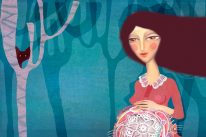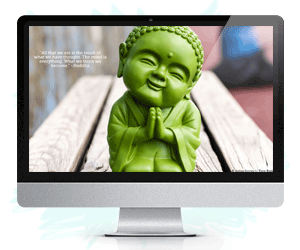
“You can’t heal what you won’t allow yourself to feel.” ~Unknown
I used to act strong all the time. On the outside, I looked like I had it all together. I was competent, composed, and capable. I was the one other people came to for advice or support.
The stickiness was that my version of strength created distance. I couldn’t allow myself to appear weak because I was terrified that if I let myself break down, I wouldn’t be able to pull myself back together.
Maybe underneath it all, I was so fragile I might actually break.
So I held it in. All of it—my grief, my fear, my loneliness. This is what strong people do, right?
I learned to be strong early because I had to.
My mother was depressed and suicidal for the younger years of my life. From a young age, I felt like it was up to me to keep her alive. I became the caretaker, the one who made things okay, even when nothing was.
My father left before I was born. I didn’t meet him until I was six, and when I did, it wasn’t safe. He was abusive and schizophrenic. One time, he tried to strangle me. That moment embedded something deep: every moment is a risk. To survive, I learned to stay alert, in control, and numb.
Later, my mum entered a same-sex relationship—a bold move in the eighties, when that kind of love wasn’t accepted. Her partner, a former homicide detective turned trauma therapist, was emotionally volatile and narcissistic. My home didn’t feel safe. There wasn’t a lot of room for me to be a child.
So, I became hyper-responsible. A perfectionist. A fixer. I micromanaged not only my life but also the emotions of others when I could. My version of “strength” became what I hid behind and my identity.
But underneath it all, I was scared. My “strength” was survival, not freedom.
Years later, I moved to Australia and found myself with a friend in a power vinyasa yoga class. It was hot, sweaty, and intense. I hated it. The carpet smelled. The teacher talked the entire time. I was angry.
And then it hit me: I was always angry.
Beneath the appearance of having it all together, I was exhausted and resentful. The yoga mat didn’t create these feelings—it just revealed what I had been carrying all along.
That night, something shifted. I realized my “strength” wasn’t really strength; it was my wall. A wall that had kept me safe but also kept me from feeling.
So, I kept going back. First to yoga, then to a deeper journey of healing.
The process came in layers.
Along my healing journey, I explored many different modalities. The first was EFT (emotional freedom technique), where I touched emotions I had buried for decades. Later, kinesthetic processing showed me that it was safe to feel everything—every emotion, every memory—through my body. This was the beginning of softness integrating into my life, not just as an idea, but as a lived experience.
For so long, my strength had been armor—the courage to survive. But softness opened something new: the courage to thrive, because my heart was no longer closed.
There was no single breakthrough, no magic moment.
With each layer that fell away, I began to replace resistance with openness, walls with connection. Slowly, I came to trust that softness wasn’t something to fear—it was something I could lean into.
And what I learned is this: my healing required softness, which meant vulnerability and allowing myself to fully feel.
Softness isn’t weakness.
It’s staying open when everything in you wants to shut down.
It’s allowing yourself to be seen without the mask.
It’s choosing presence over performance.
True power isn’t control. It’s vulnerability. It’s feeling your way through life and trusting yourself—trusting your thoughts, your decisions, and your impulses so you stop second-guessing and stop relying on constant external validation. Trust allows you to act from clarity instead of fear.
It’s trusting your body, noticing what nourishes you versus what depletes you, and setting boundaries without guilt. It’s trusting life’s natural flow, letting go of the pressure to force things to happen according to a strict schedule. It’s trusting your own inner truth. Trust and softness go hand in hand; the more you trust yourself, the more you can stay open and present without fear.
If you’ve been holding it all together for too long, maybe strength doesn’t look like pushing through. Maybe it looks like slowing down. Like taking a breath. Like feeling what’s been waiting to be felt.
And maybe, just maybe, your sensitivity isn’t something to hide or harden.
Maybe your sensitivity is your superpower.
In a world that teaches us to be strong, brave, and unshakable, we can forget that our greatest wisdom often comes in stillness.
It comes when we soften. When we listen. When we let go of who we think we should be and come home to who we already are.
Strength isn’t about being unbreakable. It’s about being real.
When I started listening to myself, I realized how often I had ignored my own needs and desires, pushing through life according to what I thought I “should” do. I learned to honor my feelings, trust my instincts, and make choices that nourished me instead of drained me. As a result, my relationships deepened, my confidence grew, and I found a sense of ease and flow I never thought possible.
Sometimes the greatest thing you can do for yourself is listen to the quiet, unchanging wisdom within you and trust what you hear.
About Shauna Hawkes
Shauna Hawkes is a women’s embodiment mentor, Gene Keys guide, and yoga teacher with over fifteen years of experience. She helps women at a crossroads break free from self-sabotage, find clarity, and step confidently into the next chapter of their lives through mentorship, workshops, yoga retreats, and Gene Keys readings. Curious to discover more about yourself? Take her free archetypes quiz at shaunahawkes.com or click this link direct - Take Quiz













 Though I run this site, it is not mine. It's ours. It's not about me. It's about us. Your stories and your wisdom are just as meaningful as mine.
Though I run this site, it is not mine. It's ours. It's not about me. It's about us. Your stories and your wisdom are just as meaningful as mine.